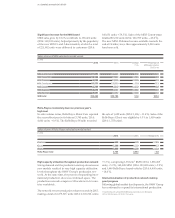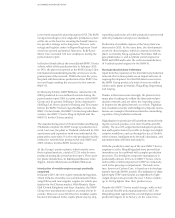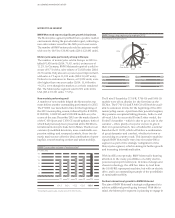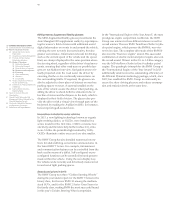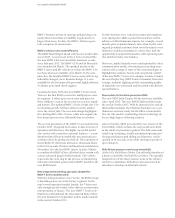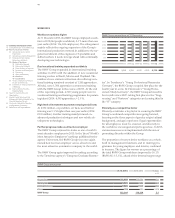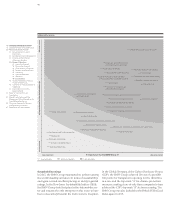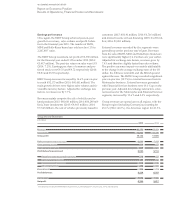BMW 2015 Annual Report Download - page 39
Download and view the complete annual report
Please find page 39 of the 2015 BMW annual report below. You can navigate through the pages in the report by either clicking on the pages listed below, or by using the keyword search tool below to find specific information within the annual report.39 COMBINED MANAGEMENT REPORT
legislators going forward. With efficient petrol- and
diesel-driven engines, plug-in hybrid systems, battery-
powered drives and also, in future, hydrogen fuel cell
electric vehicles, the BMW Group is looking to provide
suitable technologies for every segment and require-
ment.
In a prototype presented in 2015, a direct water
injec-
tion system was used for turbocharged petrol engines
for the first time. This innovative technology greatly
reduces the temperature in the combustion process,
thereby raising the efficiency factor. Moreover, the
technology reduces fuel consumption during higher
performance requirements. The newly developed
BMW 2 Series Active Tourer Plug-in Hybrid is fitted
with a 3-cylinder front-wheel-drive petrol engine, a
high-voltage generator installed at the front and an
electric motor that transfers power to the rear wheels.
The result is a road-linked all-wheel-drive system
unique in its
segment.
The hydrogen fuel cell electric drive system is destined
to become an integrated component of the Group’s
Effi cient Dynamics strategy. The diversity of drive
tech-
nologies that can be flexibly coordinated to suit varying
vehicle concepts, customer requirements and statutory
framework conditions on international markets is there-
fore growing. The hydrogen fuel cell electric drive sys-
tem, which converts hydrogen to electricity and steam,
enables locally emissions-free, electrically powered
driving with the dynamic flair typical for the BMW brand,
high suitability for covering long distances, and short
refuelling times, therefore representing a further key
option in the range of BMW eDrive technologies. The
BMW Group has been conducting research and develop-
ment work in the field of hydrogen fuel cell electric ve-
hicles for over 15 years.
Highly and fully automated driving
Assistance systems increase both safety and conveni-
ence levels while driving, although the degree of driver
support differs. Fully automated assistance systems of-
fer the highest degree of automation. Fully automated
functions are those which no longer need to be moni-
tored
by the driver. As with the fully automated Remote
Valet Parking Assistant, the driver does not even need
to be in the vehicle. Highly automated systems are the
stage before fully automated systems and do not need
to be constantly monitored by the driver. They con-
trol both the longitudinal (driving forwards and back-
wards) and latitudinal (driving to the left or right by
steering) movements of the vehicle. By contrast, al-
though semi-automated systems are capable of con-
trolling both the longitudinal and latitudinal move-
ments of the vehicle (e. g. congestion assistant), they
need to be continually monitored by the driver. As-
sisted systems (such as ACC) on the other hand, only
support the driver when driving forwards or steering
left or right.
At the Consumer Electronics Show (CES) in Las Vegas
in 2015, the BMW Group presented a BMW i3 research
vehicle that demonstrated how parking spaces can be
found in a multi-storey car park with a fully automated,
driverless vehicle. The advantages are less vehicle
damage and far better use of the available parking
space. Laser scanners installed on the vehicle create an
exact picture of the surroundings. The Remote Valet
Parking Assistant links this information with the digital
floor plan of the car park and, based on this data, is capa-
ble
of automatically driving the vehicle to a free space
and parking it. When the driver wishes to leave again,
he or she calls the vehicle (via smartwatch, for example)
and it automatically drives to the car park exit, ready to
continue to its next destination, without having to rely
on a GPS signal. As the research vehicle is fitted not only
with its own laser sensors but also with its own computers
and the required algorithms, it can calculate its exact
position in the car park, perfectly monitor its surround-
ings
and independently navigate, fully automatically.
Multi-storey car parks do not need to be elaborately
equipped with special infrastructure. The new BMW 7 Se-
ries
can already park straight in and out of a parking
space via remote control. The fully automated Parking
Assistant demonstrated in the prototype is a logical con-
tinuation of this innovative technological progress.
At the CES, a further research vehicle was presented
featuring a fully automated system that warns the driver
in the event of an imminent collision and automatically
triggers a braking manoeuvre precise to the last centi-
metre if required. Up to a certain speed, the test vehicle
makes it practically impossible for the driver to collide
with another obstacle. In order to achieve this feat, cam-
eras, radar and laser sensors record the entire
surround-
ings of the vehicle. Collision-free driving forms the basis
for taking a crucial step towards achieving accident-free
individual mobility and for that reason the BMW Group
has been working for many years to implement this vi-
sion.
Assistance systems such as Active Cruise Control
with a stop-and-go feature (ACC) are already built into
the latest BMW models and react to vehicles driving
ahead. They are radar- and camera-based and apply the
brakes, even until the vehicle comes to a halt if necessary.




